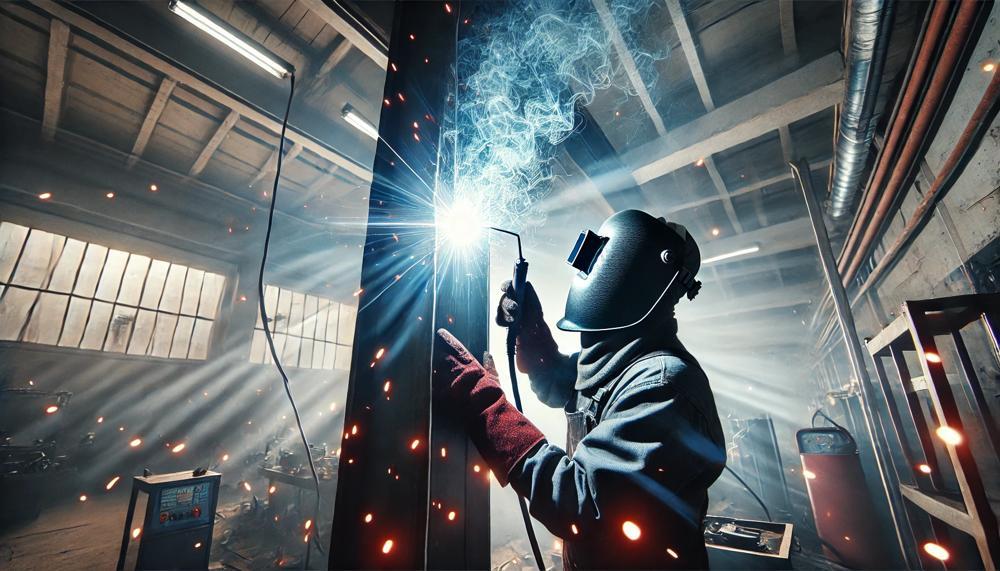Whether you’re a seasoned professional looking to refine your technique or a novice eager to master the art, understanding vertical welding is crucial in expanding your welding repertoire.
Vertical welding, characterized by its upward or downward direction, is not just another technique; it’s a testament to a welder’s skill and versatility. This approach is vital in various construction and manufacturing scenarios where horizontal welding is not feasible. Here’s what we’ll dive into:
- The Benefits: From stronger welds to the ability to work in tight spaces, we’ll explore why vertical welding is a game-changer in the welding world.
- The Challenges: It’s not all smooth sailing; vertical welding comes with its hurdles, such as gravity’s effect on the weld pool and the necessity for steady hand control. We’ll tackle these head-on with practical solutions.
- Practical Tips and Techniques: Get ready for actionable advice that will transform your vertical welding practice, including position, speed, and temperature control.
Our journey through vertical welding will equip you with the knowledge and skills to tackle any project with confidence. Whether you’re constructing a high-rise or working on custom fabrications, mastering vertical welding will set you apart in the welding community.
So, buckle up as we embark on this enlightening path, ensuring you come away with a solid foundation in one of the most challenging yet rewarding welding techniques.
Contents
Can you weld vertically with MIG?
Yes, you can certainly use MIG (Metal Inert Gas) welding for vertical welds. MIG welding, with its versatility and simplicity, serves well in handling vertical welds, though it does demand a bit of skill and practice.
This method is well-suited for both thin and thick materials, making it a popular choice in various industries, from automotive repair to construction.
Key Considerations for Vertical MIG Welding
- Welding Technique: The success of vertical MIG welding hinges on the welder’s technique. The “pull” or “drag” technique is often recommended, as it allows for deeper penetration and better control over the weld pool.
- Welding Speed: Welding vertically requires a slower speed to ensure the weld pool doesn’t run or sag. Patience and a steady hand are crucial.
- Voltage and Amperage Settings: Adjusting the voltage and amperage settings is vital to accommodate the vertical position. These adjustments help manage the weld pool’s behavior against gravity.
Advantages of Vertical MIG Welding
- Efficiency: MIG welding is known for its speed and efficiency, making it ideal for projects requiring vertical welds.
- Versatility: It can be used on a wide range of materials, including carbon steel, stainless steel, and aluminum.
- Ease of Use: Though vertical welding poses challenges, MIG welding is relatively easy to learn with practice.
Challenges of Vertical MIG Welding

- Gravity: Working against gravity can make controlling the weld pool more difficult, requiring skill to prevent sagging or dripping.
- Accessibility: Vertical welding often involves working in less accessible positions, demanding good technique and positioning from the welder.
Tips for Successful Vertical MIG Welding
- Practice: Perfecting your technique on scrap materials can significantly improve your vertical welding outcomes.
- Control Heat Input: Be mindful of the heat input to avoid warping or burn-through, especially on thinner materials.
- Proper Equipment Setup: Ensure your MIG welder is properly set up for the task, with the right wire and gas selection.
Do you MIG weld uphill or downhill?
The crux of the matter in MIG welding is whether to weld uphill or downhill, each with its own set of strengths and situations where it shines.
Uphill Welding refers to the technique where the welding starts at the lower end of the joint and progresses upwards. This method is typically employed for thicker materials or when a stronger weld is required. It allows for deeper penetration as the heat builds up and moves upwards, ensuring a robust join. However, it demands more dexterity due to the gravitational pull affecting the weld pool, making it a bit of a challenge to master.
Downhill Welding, on the flip side, begins at the top of the joint and advances downwards. It’s the go-to method for thinner materials or when speed is of the essence. Downhill welding offers a quicker weld, with less heat input reducing the risk of warping or burning through the material. Though easier to control thanks to gravity aiding the flow of the weld pool, it may not penetrate as deeply, potentially compromising the strength of the weld on thicker materials.
Here’s a simple table summarizing the key points:
| Aspect | Uphill Welding | Downhill Welding |
| Material Thickness | Thicker | Thinner |
| Weld Strength | Higher | Lower |
| Heat Input | Higher | Lower |
| Speed | Slower | Faster |
| Skill Required | More | Less |
In essence, choosing between uphill and downhill welding in MIG welding boils down to the specifics of your project. For thicker metals or projects requiring maximum strength, uphill welding is your ally. Conversely, for thinner materials or when time is tight, downhill welding will serve you well.
Is it easier to MIG weld up or down?
Deciding whether to MIG weld in a vertical up or down position is shaped by a handful of pivotal factors. Each direction has its advantages and is better suited for particular situations.
Factors to Consider
- Material Thickness: Thicker materials generally fare better with uphill welding due to deeper penetration, ensuring a stronger bond. Conversely, for thinner materials, downhill welding is often preferred as it reduces the risk of burn-through and allows for quicker execution.
- Weld Strength and Quality: Uphill welding typically produces welds of higher strength and quality. This method allows for better control over the weld pool, leading to more consistent bead appearance and penetration.
- Speed and Efficiency: Downhill welding is faster than uphill because it involves a larger electrode and higher travel speeds. This makes it more efficient for projects where time is of the essence and the utmost strength is not the primary concern.
- Welder’s Skill Level: Uphill welding requires more skill and control to manage the weld pool effectively. Beginners might find downhill welding more approachable due to its faster pace and easier control.
- Project Requirements: The specific requirements of the project, such as the desired appearance of the weld, its mechanical properties, and applicable codes or standards, can dictate the preferred welding position.
Summary in Table Format
| Factor | Uphill Welding | Downhill Welding |
| Material Thickness | Better for thick | Better for thin |
| Weld Strength and Quality | Higher | Lower |
| Speed and Efficiency | Slower | Faster |
| Welder’s Skill Level | More skill required | Easier for beginners |
| Project Requirements | Depends on strength/quality needs | Depends on time/speed needs |
Vertical uphill settings
When tackling the task of vertical uphill welding, certain key factors must be judiciously considered to ensure the weld is strong, durable, and aesthetically pleasing.
This type of welding requires a blend of skill, knowledge, and the right settings to master the uphill technique, which is favoured for its ability to produce high-quality welds with excellent penetration and a cleaner finish compared to downhill welding. Below, we’ll delve into the critical elements that should be on your radar before you strike an arc.
Key Factors for Vertical Uphill Welding:
| Amperage Setting | Opt for a lower amperage to control the heat input and reduce the chances of burn-through, especially on thinner materials. |
| Electrode Angle | Keep the electrode at a 5 to 15-degree angle to the workpiece, pointing upwards to aid in controlling the weld pool and ensuring good penetration. |
| Travel Speed | Adjust your travel speed to ensure the weld pool doesn’t become too large and unwieldy, which can lead to sagging or poor penetration. |
| Electrode Type | Use an electrode that is well-suited for vertical welding, such as E7018 for its ease of use and slag control. |
| Welding Technique | Employ a weave or stringer bead technique depending on the joint design and thickness, focusing on maintaining a consistent arc length. |
| Shielding Gas | If using MIG welding, select an appropriate shielding gas mix. A higher percentage of argon is beneficial for achieving a smoother arc and better control. |
| Material Preparation | Ensure the material is clean and free from contaminants. A good bevel and proper fit-up are crucial for achieving optimal penetration and fusion. |
Each of these factors plays a pivotal role in the outcome of your vertical uphill welding efforts. Adjusting amperage settings to match the material thickness and electrode choice can significantly impact the quality of the weld.
The electrode angle and travel speed are vital for controlling the weld pool, especially when working against gravity. The choice of electrode and shielding gas further influences the stability of the arc and the cleanliness of the weld. Lastly, thorough material preparation lays the groundwork for a successful weld.
Uphill MIG welding basics
Uphill MIG welding, also known as vertical-up welding, contrasts significantly with downhill MIG welding. The main distinctions revolve around the weld’s penetration, speed, and the skill level required.
Uphill welding is preferred for its deeper penetration, making it ideal for thicker materials, whereas downhill welding is faster, easier, and suited for thinner materials. The heat control and weld puddle manipulation are also more challenging in uphill welding, demanding finesse and swift, precise movements to prevent defects like drips or undercuts.
Key Differences in a Nutshell:
- Penetration: Uphill welding achieves greater penetration, crucial for thick materials; downhill is less penetrating, fit for thin sheets.
- Speed: Downhill welding is quicker, while uphill requires a slower pace to ensure quality and control.
- Skill Requirement: Uphill welding demands higher skill for managing the molten pool and preventing flaws.
Impact on Welding Process:
The choice between uphill and downhill MIG welding influences the welding outcome significantly. Uphill welding, with its intensive heat, necessitates adept skill to maintain a stable weld puddle and avoid common issues like sagging or excessive penetration.
Downhill welding, being faster, can be beneficial when quick, superficial welds are sufficient or when working with materials that could be compromised by excessive heat.
Practical Insights:
| Aspect | Uphill Welding | Downhill Welding |
| Material Thickness | Suitable for thicker materials | Best for thinner metals |
| Weld Penetration | Deep | Shallow |
| Technique Complexity | Requires precision and control | Easier, faster approach |
| Common Challenges | Heat management, puddle control | Ensuring even coverage, avoiding burn-through |
Mastering uphill MIG welding unlocks the capability to handle a broader array of projects, especially those necessitating robust, penetrating welds on substantial materials.
It’s about getting the hang of the rhythm, controlling the pool, and making sure your welds are not just strong, but also clean and precise.
Vertical downhill settings
When tackling vertical downhill welding, a craft requiring a deft touch and savvy know-how, fine-tuning your machine’s settings becomes paramount to achieving strong, aesthetically pleasing welds.
Here’s a straightforward guide to nudge you in the right direction:
Adjusting Amperage and Voltage
- Lower the Amperage: Compared to uphill welding, vertical downhill welding allows for a quicker travel speed, necessitating less heat input to prevent excessive melt-through. Dialling down the amperage helps maintain control over the weld pool.
- Voltage Adjustments: A slight reduction in voltage can help keep the arc tight and focused, aiding in preventing the weld bead from becoming too wide or sloppy.
Wire Feed Speed
- Find the Sweet Spot: The wire feed speed should match the adjusted amperage to ensure a stable arc and appropriate penetration. Too slow, and the arc might stutter or fail; too fast, and the weld could become unwieldy.
Electrode Angle and Type
- Electrode Angle: Keep the electrode tilted slightly away from the direction of travel. This stance helps control the weld pool and ensures better penetration into the leading edge of the weld.
- Select the Right Electrode: For vertical downhill welding, E6013 electrodes are often recommended due to their fast-freezing slag, which helps in creating a shelf to hold the molten pool in place.
Travel Speed
- Speed is Key: A brisker travel speed is typically necessary to prevent the weld pool from getting ahead of the arc and sagging or creating unwanted drips.
Downhill MIG welding basics
Downhill MIG welding, a technique where the welder moves the torch downwards along the joint, contrasts sharply with the uphill method, especially in terms of penetration, control, and application. Understanding these distinctions and the scenarios where downhill welding shines is key for any welder looking to master vertical welding.
Main Differences between Uphill and Downhill MIG Welding
The core disparities between uphill and downhill welding in MIG (Metal Inert Gas) processes lie in their penetration levels, control over the weld pool, and the thickness of materials they best suit. Below is a concise comparison:
| Aspect | Uphill Welding | Downhill Welding |
|---|---|---|
| Penetration | Deeper, suitable for thick materials | Shallower, ideal for thin materials |
| Puddle Control | Enhanced, due to slower movement | Reduced, because of quicker movement |
| Best Used For | Thick metals, requiring strong joints | Thin metals or open root pipes |
| Visibility | Better, as the weld builds up | Can be challenging, due to faster travel |
When to Prefer Downhill Welding for Vertical Welding
Downhill welding is the go-to method in specific circumstances due to its unique advantages:
- Thin Metal Work: When dealing with thin materials, such as automotive panels or sheet metal, the lesser penetration of downhill welding prevents burn-through, making it the superior choice.
- Speed: Downhill welding allows for quicker completion of welds, beneficial in high-production settings where efficiency is paramount.
- Ease and Accessibility: For welders at the beginning of their journey, the downhill technique can be easier to master due to its straightforward approach and less rigorous control requirements.
In essence, while uphill welding offers depth and strength, particularly for thicker, more demanding jobs, downhill MIG welding provides a fast, accessible solution for lighter materials where a delicate touch is needed to prevent damage.
Tips for vertical MIG
When it comes to mastering vertical MIG welding, it’s a blend of art and skill. Here are some tailored tips to help you achieve success:
| Tip | Description | Reason |
|---|---|---|
| Wire Speed and Voltage | Adjust wire speed and voltage for optimal arc stability. This varies depending on material thickness. | Stable arc reduces spatter and improves bead appearance. |
| Welding Technique | Use a ‘zig-zag’ or ‘triangle’ technique, pausing at the sides. | Ensures even heat distribution and penetration, avoiding sagging of the weld pool. |
| Travel Speed | Maintain a steady travel speed; not too fast, not too slow. | Prevents overheating and lack of fusion. |
| Weld Direction | Weld uphill for thinner materials, downhill for thicker ones. | Uphill maximizes penetration, while downhill speeds up the process. |
| Electrode Stick-out | Keep a short stick-out, about 3/8 inch. | Short stick-out offers better control and arc stability. |
| Torch Angle | Use a slight drag angle. | Improves penetration and bead shape. |
Remember, practice makes perfect. Experiment with scrap pieces first to fine-tune your settings and technique. A steady hand and a keen eye for detail are your best friends in vertical MIG welding.
Conclusion
Learning vertical welding is a lot like learning an art form: it requires both skill and science to work together in the right way. Some situations call for strong answers that horizontal options can’t provide. This is where vertical welding comes in. This method stands out because it is very difficult—gravity is always against you—but it makes the welds stronger and more durable for those who work hard at it.
The main benefits of vertical welding are that it is strong and flexible, making it essential in fields where strength and stability are paramount. To become good at vertical welding, you need to understand and get past the problems that come with it. For example, you need to learn how to control the weld pool, handle heat well, and make your method fit the vertical plane.
To be good at vertical welding, you need to understand how speed, angle, and temperature work together and how to carefully adjust each one to get the most out of this important skill. Your success depends on how well you use your torch, whether you point it up or down. This is because you need to be precise, patient, and practice.
When vertical MIG welding, the choice between uphill and downhill ways lets you tailor your approach even more to the material you’re working with. Each has its own strategic benefits. For thicker materials, uphill welding is best because it has better penetration and strength. For lighter surfaces, downhill welding is best because it is faster and more efficient.
Perfecting the skill of vertical welding requires a lot of ongoing learning and hands-on practice. It’s both satisfying and difficult to get good at it.





